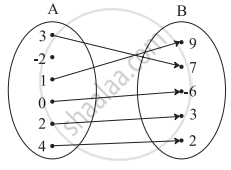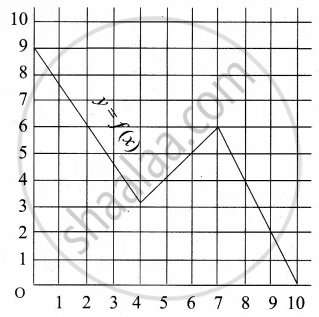Advertisements
Advertisements
प्रश्न
The equation logx2 16 + log2x 64 = 3 has,
विकल्प
one irrational solution
no prime solution
two real solutions
one integral solution
उत्तर
two real solutions
Explanation;
logx2 16 + log2x 64 = 3
∴ `(log_(2)16)/(log_(2)x^2) + (log_(2)64)/(log_2(2x))` = 3
∴ `(log_(2)2^4)/(2log_(2)x) + (log_(2)2^6)/(log_(2)2 + log_(2)x` = 3
∴ `(4log_(2)2)/(2log_(2)x) + (6log_(2)2)/(1 + log_(2)x)` = 3
∴ `2/"m"+6/(1+"m")` = 3 .....[m = log2 x]
∴ 2(1 + m) + 6m = 3m(1 + m)
∴ 2 + 2m + 6m = 3m + 3m2
∴ 3m2 – 5m – 2 = 0
∴ 3m2 – 6m + 1m – 2 = 0
∴ 3m(m – 2) + 1(m – 2) = 0
∴ (m – 2)(3m + 1) = 0
∴ m – 2 = 0 or 3m + 1 = 0
∴ m = 2 or m = `-1/3`
∴ log2 x = 2 or log2 x = `-1/3`
∴ x = 4 or x = `2^(-1/3)`
APPEARS IN
संबंधित प्रश्न
Let f : R+ → R, where R+ is the set of all positive real numbers, such that f(x) = loge x. Determine
(c) whether f(xy) = f(x) : f(y) holds
Let X = {1, 2, 3, 4} and Y = {1, 5, 9, 11, 15, 16}
Determine which of the set are functions from X to Y.
(b) f2 = {(1, 1), (2, 7), (3, 5)}
If \[y = f\left( x \right) = \frac{ax - b}{bx - a}\] , show that x = f(y).
If f(x) = (a − xn)1/n, a > 0 and n ∈ N, then prove that f(f(x)) = x for all x.
If for non-zero x, af(x) + bf \[\left( \frac{1}{x} \right) = \frac{1}{x} - 5\] , where a ≠ b, then find f(x).
Let f and g be two real functions defined by \[f\left( x \right) = \sqrt{x + 1}\] and \[g\left( x \right) = \sqrt{9 - x^2}\] . Then, describe function:
(ii) g − f
Let f and g be two real functions defined by \[f\left( x \right) = \sqrt{x + 1}\] and \[g\left( x \right) = \sqrt{9 - x^2}\] . Then, describe function:
(iv) \[\frac{f}{g}\]
Let f : [0, ∞) → R and g : R → R be defined by \[f\left( x \right) = \sqrt{x}\] and g(x) = x. Find f + g, f − g, fg and \[\frac{f}{g}\] .
Let f(x) = x2 and g(x) = 2x+ 1 be two real functions. Find (f + g) (x), (f − g) (x), (fg) (x) and \[\left( \frac{f}{g} \right) \left( x \right)\] .
Let f and g be two real functions given by
f = {(0, 1), (2, 0), (3, −4), (4, 2), (5, 1)} and g = {(1, 0), (2, 2), (3, −1), (4, 4), (5, 3)}
Find the domain of fg.
If \[f\left( x \right) = \frac{\sin^4 x + \cos^2 x}{\sin^2 x + \cos^4 x}\] for x ∈ R, then f (2002) =
The domain of the function \[f\left( x \right) = \sqrt{\frac{\left( x + 1 \right) \left( x - 3 \right)}{x - 2}}\] is
If \[\left[ x \right]^2 - 5\left[ x \right] + 6 = 0\], where [.] denotes the greatest integer function, then
Check if the following relation is function:

Check if the following relation is a function.

Which sets of ordered pairs represent functions from A = {1, 2, 3, 4} to B = {−1, 0, 1, 2, 3}? Justify.
{(1, 1), (2, 1), (3, 1), (4, 1)}
If f(m) = m2 − 3m + 1, find `f(1/2)`
Find the domain and range of the following function.
f(x) = `sqrt(16 - x^2)`
Express the area A of circle as a function of its circumference C.
An open box is made from a square of cardboard of 30 cms side, by cutting squares of length x centimeters from each corner and folding the sides up. Express the volume of the box as a function of x. Also find its domain
Check the injectivity and surjectivity of the following function.
f : Z → Z given by f(x) = x2
Express the following exponential equation in logarithmic form
25 = 32
Solve for x.
2 log10 x = `1 + log_10 (x + 11/10)`
If f(x) = 3x + 5, g(x) = 6x − 1, then find (f − g) (2)
Select the correct answer from given alternatives.
If f(x) =`1/(1 - x)`, then f{f[f(x)]} is
Select the correct answer from given alternatives
The domain of `1/([x] - x)` where [x] is greatest integer function is
Answer the following:
Find whether the following function is one-one
f : R − {3} → R defined by f(x) = `(5x + 7)/(x - 3)` for x ∈ R − {3}
Answer the following:
Show that `7log (15/16) + 6log(8/3) + 5log (2/5) + log(32/25)` = log 3
Answer the following:
Find the range of the following function.
f(x) = `x/(9 + x^2)`
Answer the following:
Find the range of the following function.
f(x) = `1/(1 + sqrt(x))`
A graph representing the function f(x) is given in it is clear that f(9) = 2

Find the following values of the function
(a) f(0)
(b) f(7)
(c) f(2)
(d) f(10)
Let A = {1, 2, 3, 4} and B = N. Let f : A → B be defined by f(x) = x3 then, find the range of f
The domain of the function f(x) = `sqrtx` is ______.
If a function f(x) is given as f(x) = x2 – 6x + 4 for all x ∈ R, then f(–3) = ______.
Find the domain for which the functions f(x) = 2x2 – 1 and g(x) = 1 – 3x are equal.
Find the range of the following functions given by f(x) = |x − 3|
Let f(x) = `sqrt(x)` and g(x) = x be two functions defined in the domain R+ ∪ {0}. Find (f + g)(x)
Range of f(x) = `1/(1 - 2 cosx)` is ______.
